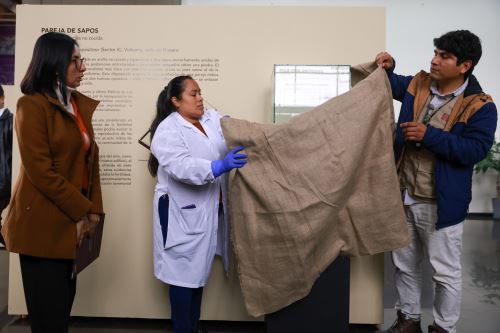01:03 | Huaura (Lima region), Aug. 31.
New discoveries at the Vichama archaeological complex, located in Vegueta district, Huaura province of Lima, support the hypotheses that climate change had significant effects 3,800 years ago in this area of the Peruvian coast, influencing the course of its population.
The results of the recent investigations at this point of Lima's "norte chico," linked to the Caral Civilization, were recently presented by the team led by archaeologist Ruth Shady.
Vichama flourished between the years 1800 B.C. and 1500 B.C. It is considered an urban center whose population developed a water cult.

On this occasion, celebratory activities were announced for the 18th anniversary of the beginning of investigations in Vichama. These became possible after the scholar and the then-Mayor of Vegueta, Jose Li, discussed the monumental archaeological heritage found there.
In this regard, Shady indicated that the research conducted since 2007 confirmed that this site succeeded the city of Caral in time and, like Caral, was also affected by climate change.
She added that it likewise impacted Mesopotamian and Egyptian civilizations.
This difficult situation is evidenced by the anthropomorphic representations that can be seen in the Mural of the Dance of Life and Death, which is found in one of the largest and most important architectural structures discovered at the site, she said.
In turn, Tatiana Abad, head of the Vichama headquarters at the Caral Archaeological Zone, told Andina News Agency that these representations, along with depictions of animals such as toads, snakes and other elements linked to water, would reveal a worldview reflecting the effects of climate change, evidenced in what may have been a severe drought.
"These are animals that have been living in the area and are associated with the rainy season," the archaeologist pointed out.
Similarly, she reported that skeletons of toads tied with reeds have been found, along with bones of this species in tupus and pins shaped like snakes.
The Vichama exhibition, inaugurated recently at the Ministry of Culture, features a small sculptural piece representing two joined toads.
Shady noted that it could symbolize the presence of water and fertility.
Regarding the anthropomorphic representations of skeletal people, with visible ribs and sunken stomachs, Abad stated that these bear similarity to others found in Peñico, another urban center included in research related to the Caral civilization.
As for the structures visible in Vichama, the archaeologist mentioned ceremonial public buildings and dwellings.
"But it was also a place for exchange" with other areas of the country, she added.
Abad supported this with the finding in this region of clay sculptures wrapped in textile pieces and macaw feathers, alongside chonta wood sticks —objects that denote an Amazonian origin.
Spondylus shells and minerals from the south have also been found.
Among the most notable buildings, she mentioned the one mural reliefs representing skeletal beings have been found. Another is the one where deposits are located and in whose walls representations of snakes and toads can be seen.
Vichama will celebrate the 18th anniversary of the beginning of the archaeological investigations with a festival.
This will take place in Vegueta on September 5 and 6. It will include tours of the archaeological site as well as symbolic ceremonies.

(END) FGM/JMP/MVB
Published: 8/31/2025